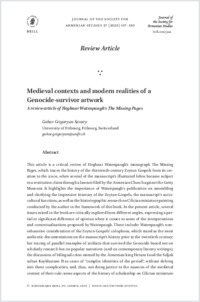Medieval contexts and modern realities of a Genocide-survivor artwork: A review article of Heghnar Watenpaugh’s The Missing Pages
BHAP-HA+SCANT
- Grigoryan Savary, Gohar Université de Fribourg
-
2020
Published in:
- Journal of the Society for Armenian Studies.. - 2020, vol. 27, p. 117-130
Art arménien
Héritage culturel
Royaume arménien de Cilicie
Roslin, Toros
Manuscrits arméniens
Evangiles
Patrimoine culturel - restitution
Génocide arménien (1015-1916)
Armenian art
Armenian studies
cultural heritage
Armenian kingdom of Cilicia
Toros Roslin
Zeytun Gospels
Armenian Genocide
restitution of cultural property
provenance studies
exhibition practices
English
This article is a critical review of Heghnar Watenpaugh’s monograph The Missing Pages, which traces the history of the thirteenth-century Zeytun Gospels from its creation to the 2010s, when several of the manuscript’s illustrated folios became subject to a restitution claim through a lawsuit filed by the Armenian Church against the Getty Museum. It highlights the importance of Watenpaugh’s publication on assembling and clarifying the impressive itinerary of the Zeytun Gospels, the manuscript’s sociocultural functions, as well as the historiographic research on Cilician miniature painting conducted by the author in the framework of this book. In the present article, several issues raised in the book are critically explored from different angles, expressing a partial or significant difference of opinion when it comes to some of the interpretations and contextualizations proposed by Watenpaugh. These include: Watenpaugh’s nonexhaustive consideration of the Zeytun Gospels’ colophons, which stand as the most authentic documentations on the manuscript’s history prior to the twentieth century; her tracing of parallel examples of artifacts that survived the Genocide based not on scholarly research but on popular narratives (and on contemporary literary writings); the discussion of bilingual coins minted by the Armenian king Hetum I and the Seljuk sultan Kaykhusraw II as cases of “complex identities of the period”, without delving into these complexities, and, thus, not doing justice to the nuances of the medieval context of their rule; some aspects of the history of scholarship on Cilician miniature painting; and the way Watenpaugh presents two of the most prominent historians of Armenian art, Sirarpie Der Nersessian and Karekin Hovsepian, and their attitudes toward the ownership and acquisition of Armenian cultural heritage by western art institutions, which appear to be less than balanced in The Missing Pages. Finally, some reflections on contemporary exhibition practices of survivor artifacts, whose current locations of preservation are often a consequence of (cultural) genocide and dubious acquisition practices, require clearer and more in-depth presentation, at least as far as the exhibition history of the Zeytun Gospels and its separated folios is concerned.
- Faculty
- Faculté des lettres et des sciences humaines
- Department
- Département d'histoire de l'art et d'archéologie
- Language
-
- English
- Classification
- Art history
- License
-
License undefined
- Identifiers
-
- RERO DOC 329669
- DOI 10.1163/26670038-12342704
- Persistent URL
- https://folia.unifr.ch/unifr/documents/308869
Statistics
Document views: 254
File downloads:
- Texte intégral: 284
